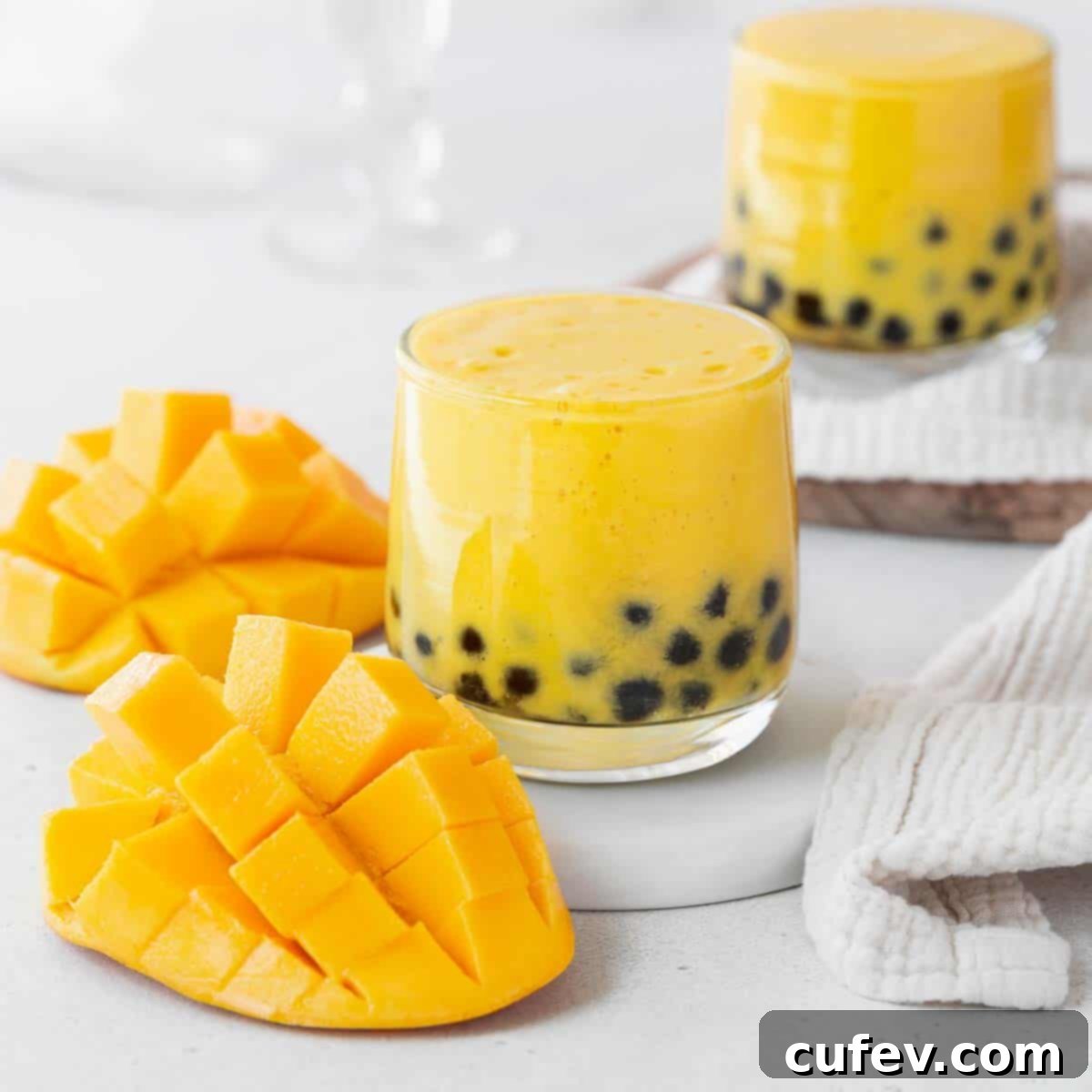Homemade Mango Boba Tea: Your Guide to a Refreshing & Creamy Bubble Tea Experience
Refreshing, light, smooth, and wonderfully creamy, Mango Boba Tea is a truly delightful beverage that can elevate any moment of your day. This vibrant, tropical drink is surprisingly simple to create at home with just a few core ingredients, making it an accessible treat for everyone. Beyond its irresistible taste, this homemade version is naturally gluten-free and dairy-free, catering to various dietary preferences and making it perfect for the entire family to enjoy. Skip the trip to your local boba shop and bring the joy of sweet, chewy tapioca pearls combined with luscious mango puree right into your kitchen!

This post is sponsored by Chef’s Choice. All opinions are my own.
Table of contents
- What is Boba Tea?
- Why You’ll Love This Mango Bubble Tea Recipe
- Ingredients
- How to Make Mango Boba
- Recipe Success Tips
- Recipe Variations
- Storage Directions
- Dietary Adaptations
- FAQs
- Tools Needed to Make This Recipe
- More Fruit Recipes
What is Boba Tea?
Boba tea, also widely recognized as bubble tea, pearl milk tea, or simply “boba,” is a Taiwanese tea-based drink that has captivated palates worldwide. It typically consists of a base of sweetened green or black tea, combined with milk (dairy or non-dairy), a fruit or other flavor, and its signature chewy element: boba. These “boba” are large, spherical tapioca pearls, known for their unique tender yet springy texture and subtly sweet flavor. Before being added to the tea, they are often steeped in a simple syrup, which enhances their sweetness and prevents them from sticking together.
The beauty of boba tea lies in its versatility. It can be served cold over ice, or blended with cold or frozen fruits for a thicker, smoothie-like consistency. While classic flavors like brown sugar, taro, and honeydew are popular, the possibilities are endless. Common fruit-based variations include strawberry, lychee, avocado, and, of course, the star of our recipe today: mango. Beyond fruit, you can also explore different tea bases such as aromatic jasmine green tea, robust black tea, or earthy matcha for a diverse range of bubble tea experiences. This refreshing beverage offers a delightful interplay of textures and tastes, making it a unique and enjoyable drink that appeals to all ages.
Why You’ll Love This Mango Bubble Tea Recipe
- Effortlessly Simple. Don’t let the exotic name fool you – making mango boba tea at home is incredibly straightforward. The process involves just three main steps: boiling the boba, soaking them in a quick simple syrup, and blending a creamy 3-ingredient mango puree. You’ll be sipping your homemade bubble tea in minutes, without any complicated techniques or specialized equipment. It’s an ideal recipe for beginners and busy individuals alike!
- Incredibly Fun. If a trip to the local boba shop is a cherished outing for you or your kids, imagine the excitement of recreating that experience together in your own kitchen! This mango boba milk tea recipe offers a fantastic opportunity for a fun, hands-on activity. Customizing your drinks and watching the pearls transform makes for an engaging and memorable culinary adventure for the whole family.
- Budget-Friendly Indulgence. While delicious, frequent visits to boba shops can quickly add up and strain your wallet. By making boba with mango at home, you can significantly cut down on costs without sacrificing any of the classic, beloved flavors. You’ll get more servings for your money, allowing you to enjoy this delightful treat whenever a craving strikes, without the guilt.
- Sweet, Fresh, and Creamy. Experience the unparalleled taste of luscious, ripe mangoes blended with rich, velvety coconut milk. This combination creates a sweet, tropical puree that is both incredibly refreshing and deeply satisfying. The natural sweetness of the mango, balanced by the subtle richness of coconut, makes a flavor profile that is truly addictive and leaves you wanting more.
- Healthier Home Control. When you make boba tea at home, you have complete control over the quality of ingredients and the amount of sugar. This allows you to tailor the sweetness to your preference and ensure you’re using fresh, wholesome components. It’s a great way to enjoy your favorite drink while being mindful of your dietary choices.
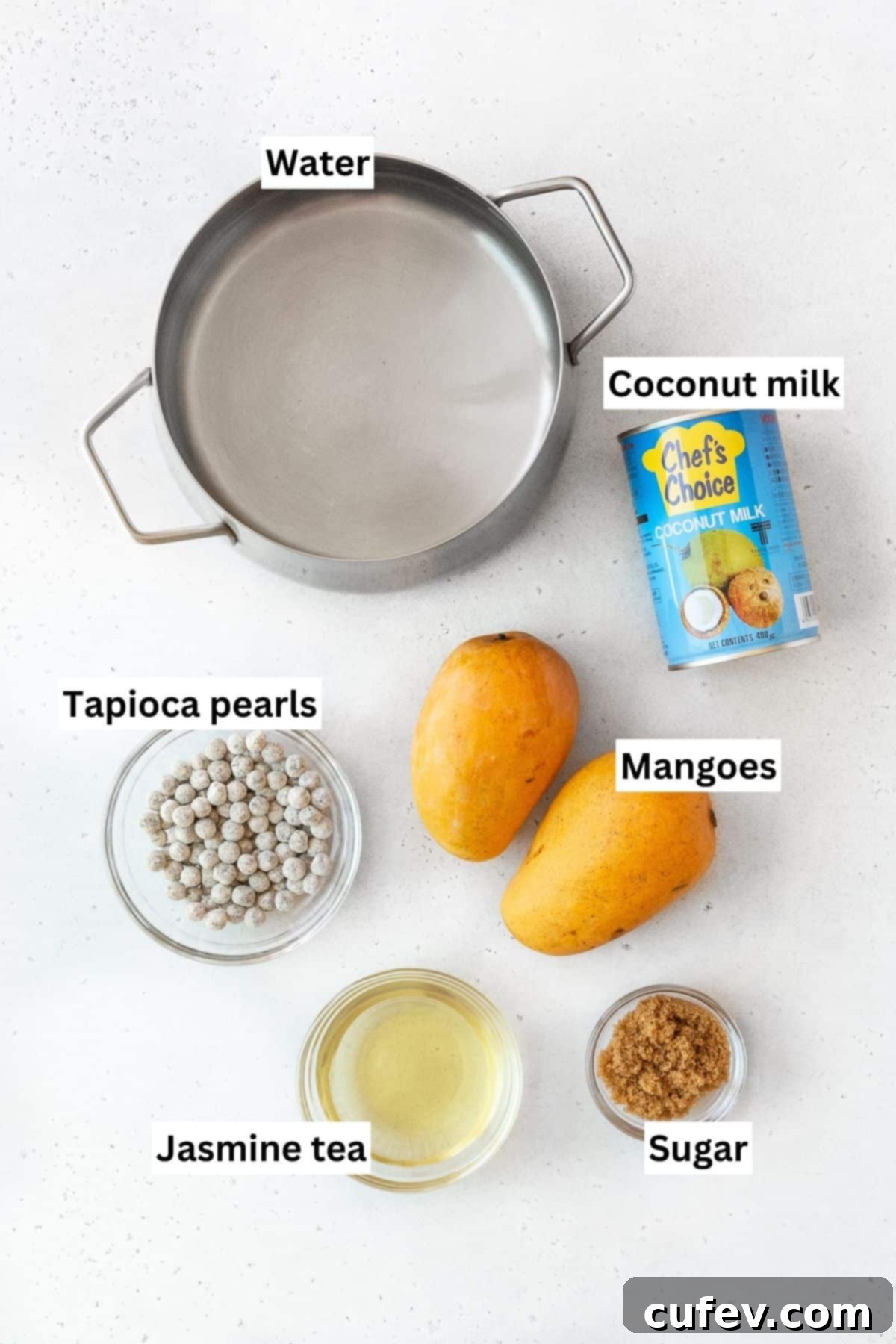
Ingredients
Crafting this invigorating mango green tea boba requires just five key ingredients, plus water. The simplicity of the component list belies the incredible depth of flavor and texture you’ll achieve. Gather these items for an easy and utterly delicious beverage:
- Mango: The heart of this tropical drink! For the best flavor, select mangoes that yield slightly when gently but firmly pressed with the heel of your thumb, indicating ripeness. Varieties like Ataulfo (also known as Champagne or Honey mangoes) and Alphonso mangoes are particularly sweet and juicy, offering a rich, less fibrous pulp. However, any sweet and ripe mango available at your local grocery store will work wonderfully. You can also use good quality frozen mango chunks for convenience; just be aware it might result in a thicker puree (see notes below).
- Boba Pearls: These large tapioca balls are the defining chewy component of any boba drink. For this recipe, look for quick-cooking black tapioca pearls, which significantly reduce preparation time. You can typically find boba pearls in the international aisle of larger supermarkets, specialty Asian markets, or conveniently online through retailers like Amazon. Ensure they are fresh for the best chewy texture.
- Green Jasmine Tea: A freshly brewed batch of jasmine green tea provides a delicate, floral, and slightly grassy base that beautifully complements the sweet mango. You can brew your own from tea bags or loose leaf (refer to our tips below for optimal brewing), or use a good quality unsweetened bottled variety for a quicker option. The subtle aroma of jasmine elevates the entire drink experience.
- Brown Sugar: This is essential for creating the luscious brown sugar simple syrup that coats and sweetens the tapioca pearls. Brown sugar adds a deeper, more caramel-like note compared to white sugar, enhancing the overall flavor complexity of the boba. Its richness truly transforms the mildly flavored tapioca into a sweet, irresistible treat.
- Coconut Milk: Full-fat canned coconut milk is the secret to achieving the luxurious richness and creamy texture of this mango boba tea. Its natural sweetness and velvety consistency blend perfectly with the mango, providing a dairy-free base that is incredibly satisfying. While light coconut milk can be used, note that the resulting mango boba milk tea may not be as rich or as creamy, so we highly recommend full-fat for the best results.
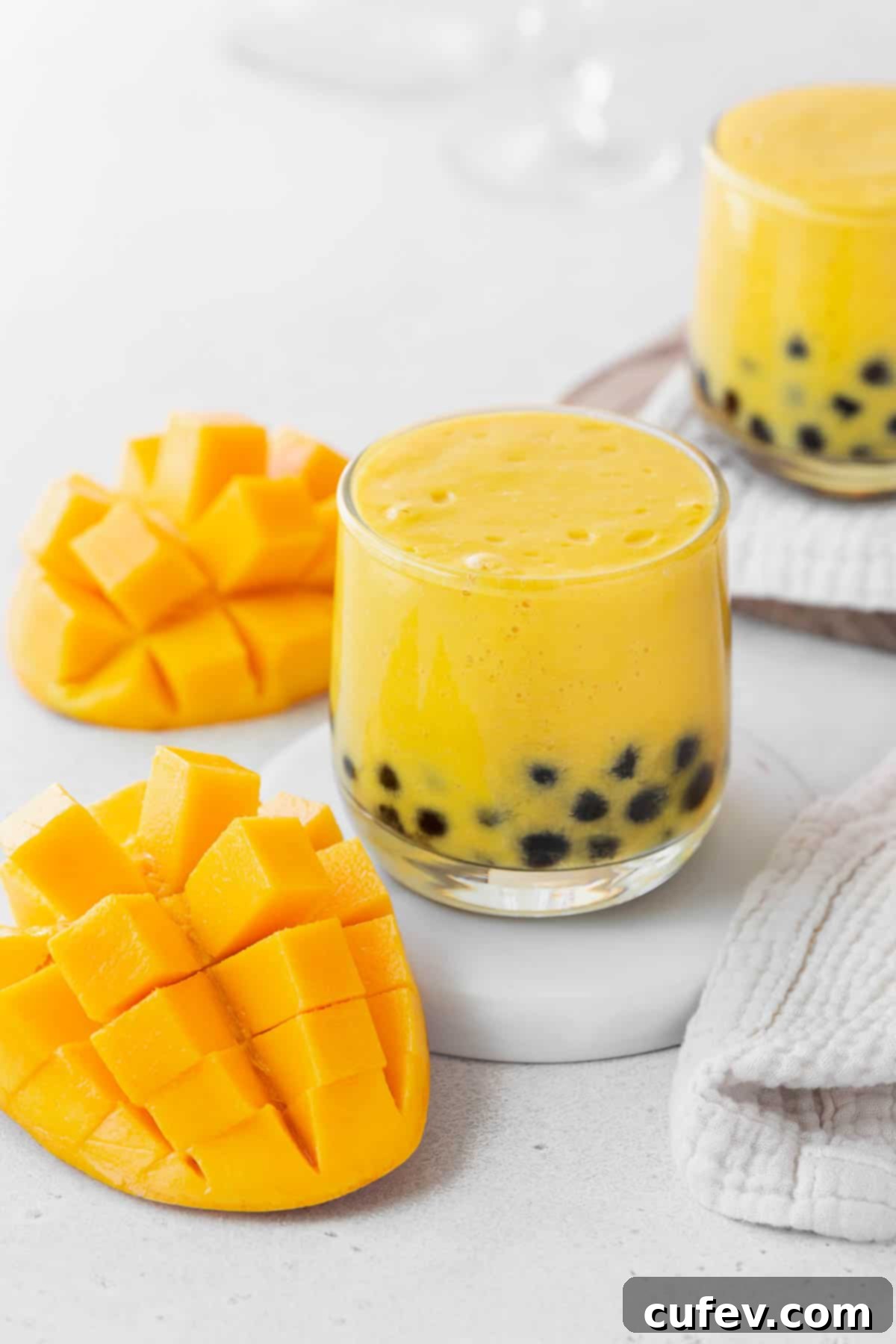
How to Make Mango Boba
While the idea of making mango bubble tea might seem daunting at first, rest assured that the process is actually quite straightforward and incredibly rewarding. By following these easy steps, you’ll be able to whip up your very own delicious mango boba tea in no time, impressing friends and family with your newfound boba-making skills!
Step 1: Begin by boiling the specified amount of water in a medium-sized pot over high heat. Once the water reaches a rolling boil, carefully add the boba tapioca pearls. Stir gently to prevent them from sticking to the bottom of the pot. Once the tapioca pearls float to the surface, cover the pot with a lid, reduce the heat to medium-low, and allow them to cook for precisely 3 minutes. This initial cooking ensures they become tender.
Step 2: After 3 minutes, turn off the heat completely, but keep the pot covered. Let the tapioca pearls continue to cook in the residual heat for an additional 2 minutes. This crucial step allows the pearls to achieve their signature chewy, yet tender, consistency without becoming mushy.
Step 3: Once the resting time is complete, carefully drain the cooked tapioca pearls using a fine-mesh sieve. Immediately rinse them thoroughly under cold running water. Rinsing stops the cooking process and removes excess starch, preventing the pearls from clumping together and ensuring they remain separate and perfectly chewy.
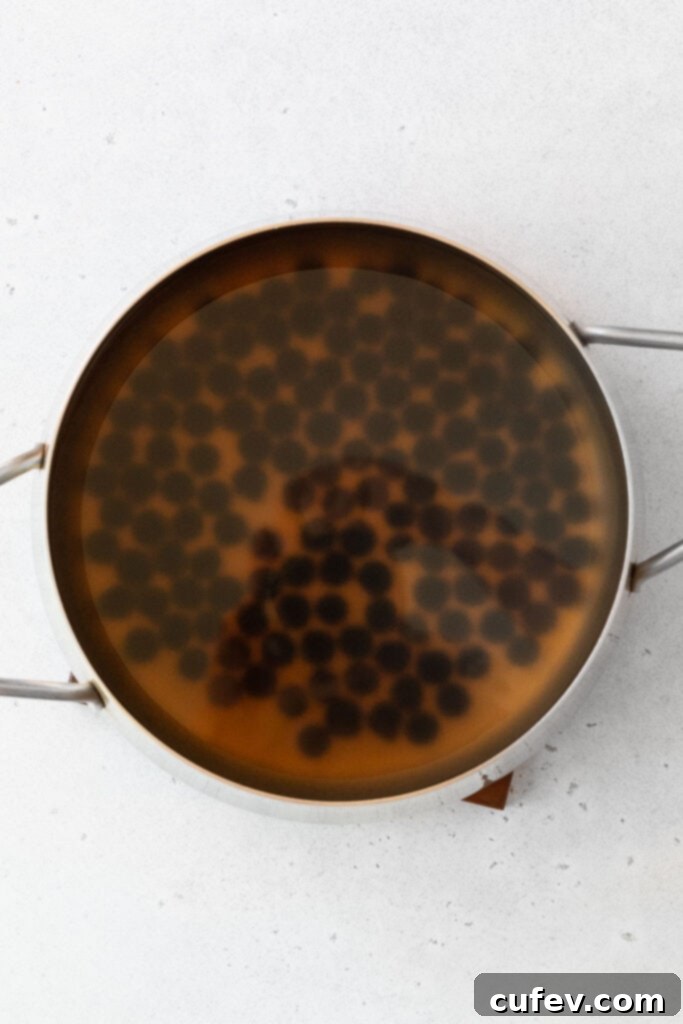
Step 4: In a separate small bowl, combine the packed brown sugar with the hot water. Stir continuously until the brown sugar is completely dissolved, forming a smooth and slightly viscous simple syrup. This syrup is key to sweetening and flavoring your boba pearls.
Step 5: Add the freshly cooked and rinsed tapioca pearls directly into the brown sugar syrup. Stir well to ensure all the pearls are evenly coated. For optimal sweetness and to prevent them from drying out, move the mixture to the refrigerator and allow the boba to soak in the syrup until you’re ready to assemble and serve your bubble tea.
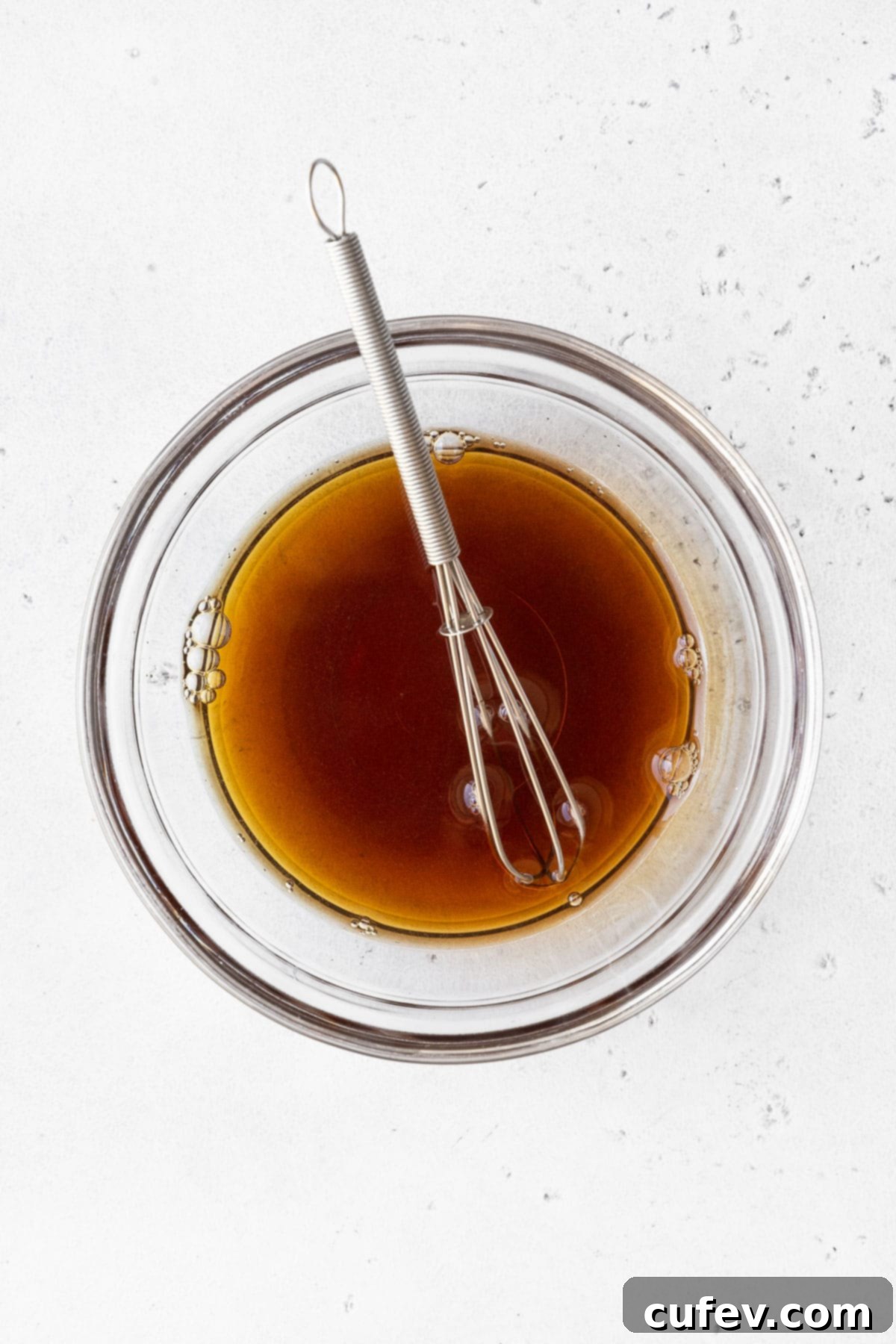
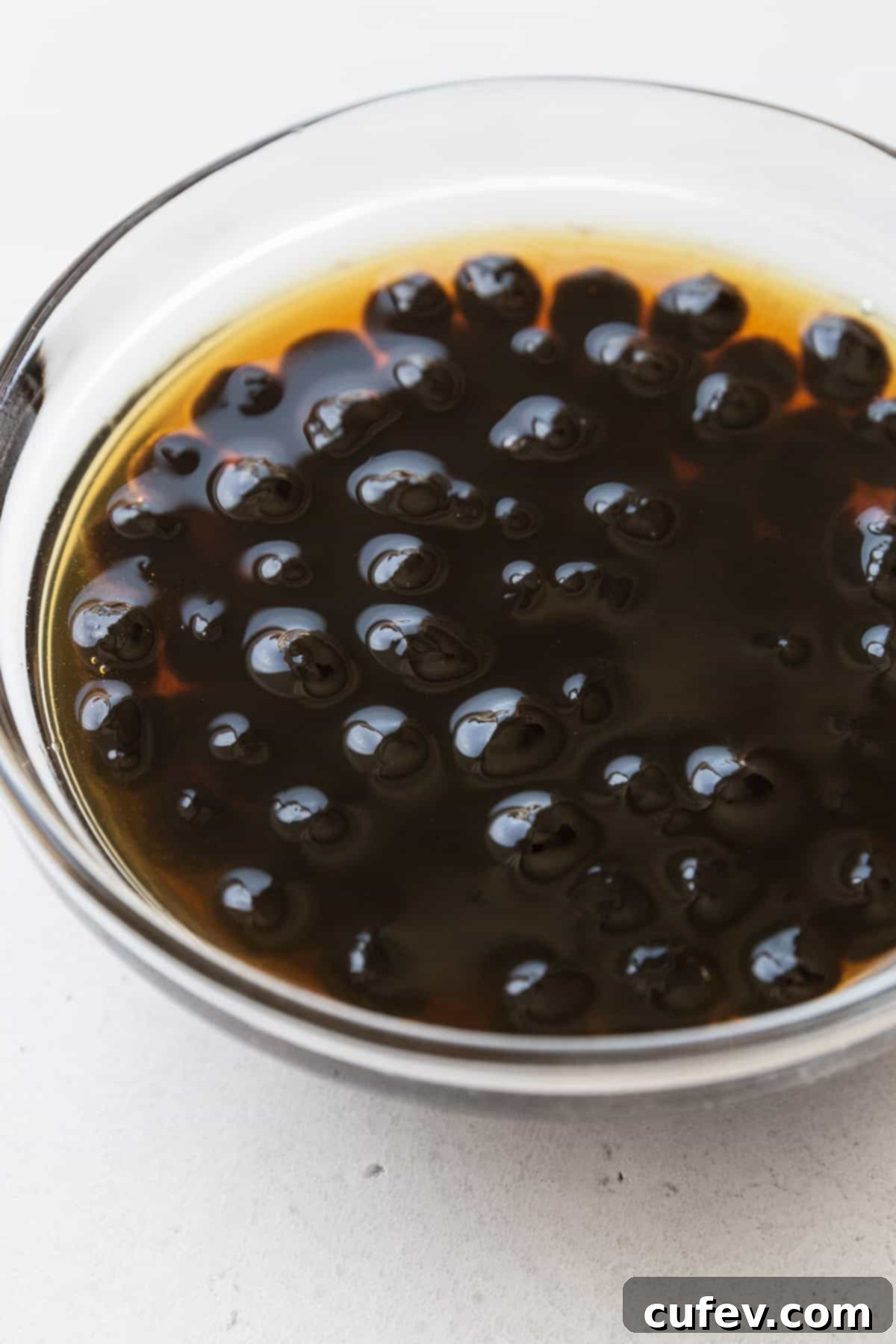
Step 6: Now, it’s time to create the creamy mango milk tea base. Add the full-fat coconut milk, fresh or frozen mango chunks, and the brewed jasmine green tea to a high-speed blender. Blend these ingredients together until the mixture is completely smooth and creamy, with no discernible mango lumps. For an extra refreshing drink, you can add a few ice cubes at this stage to blend into a frosty concoction.
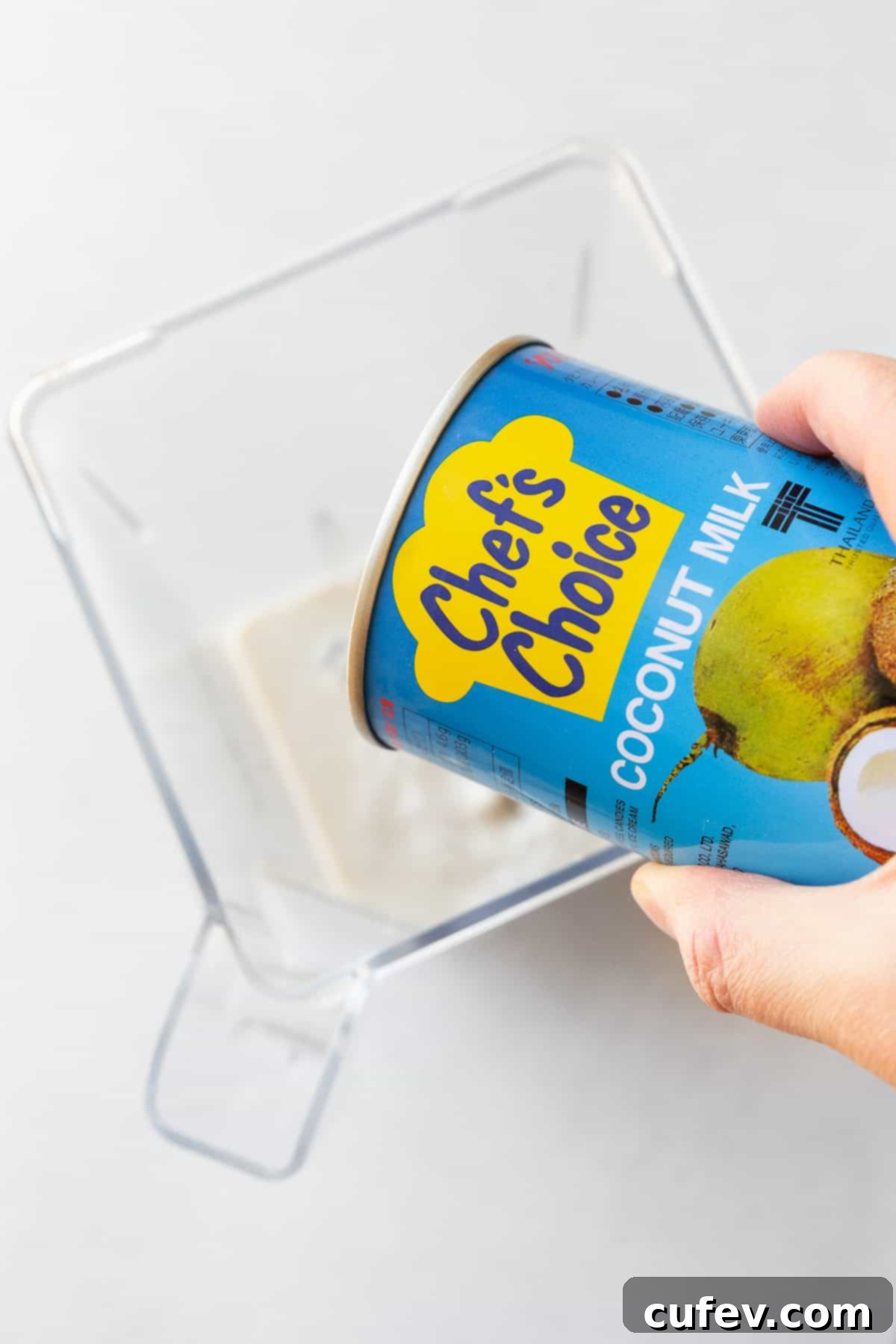
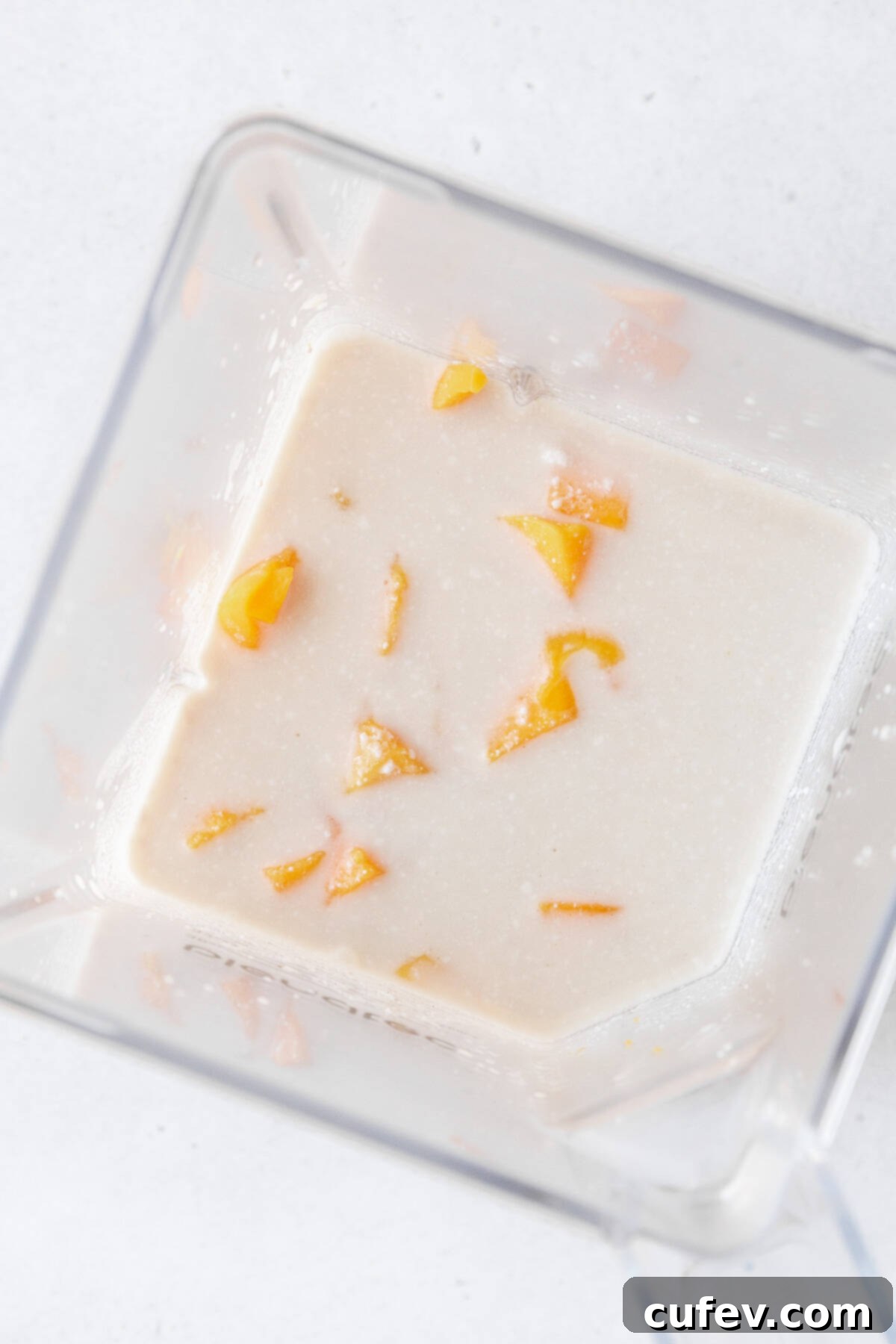
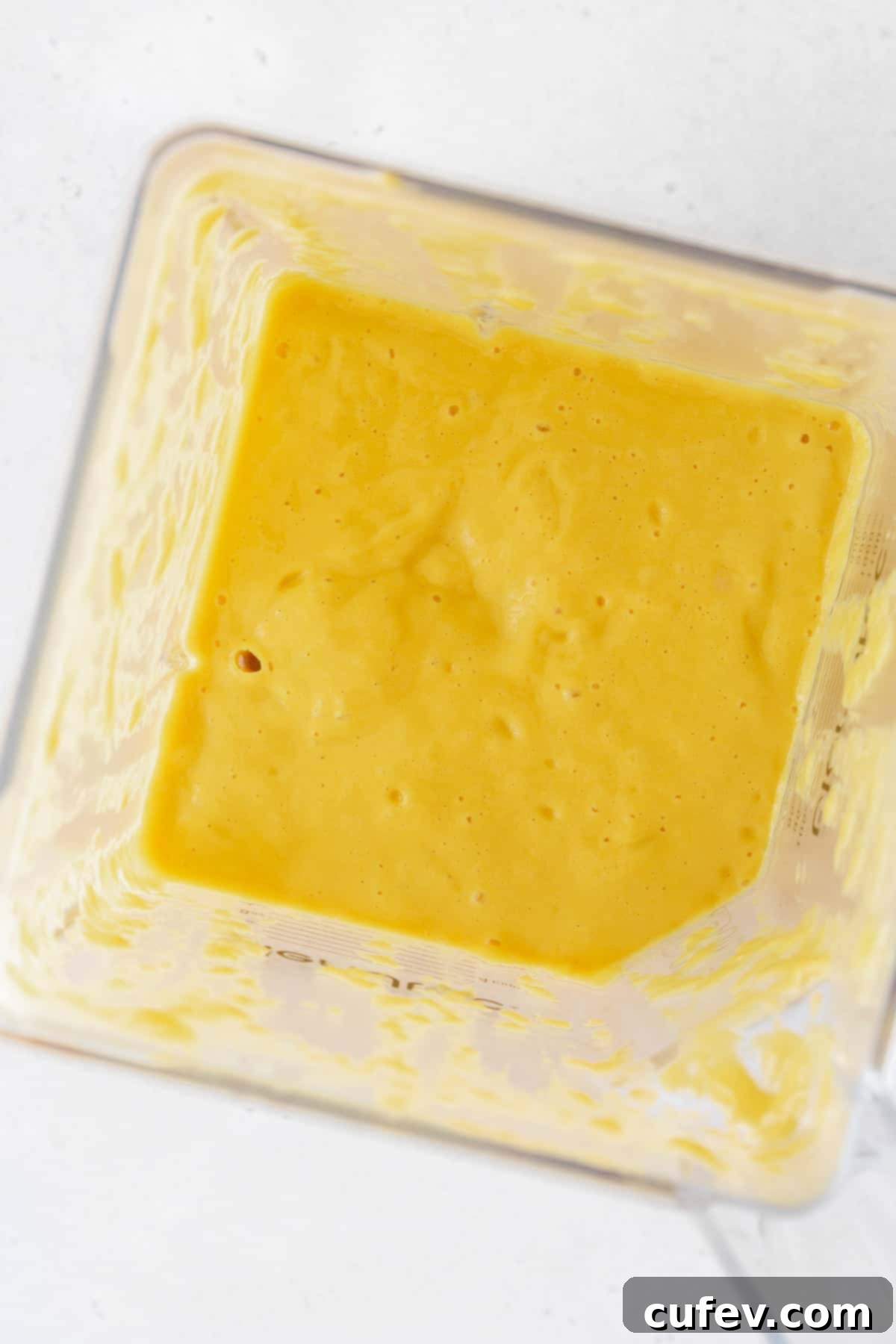
Step 7: To serve, divide the sweetened tapioca pearls evenly between two glasses. Then, pour the freshly blended mango milk tea mixture over the boba. If you desire an even colder drink, add a few extra ice cubes before serving. For the best experience, serve your homemade mango boba tea immediately to enjoy the perfect chewiness of the pearls and the refreshing creaminess of the mango tea!
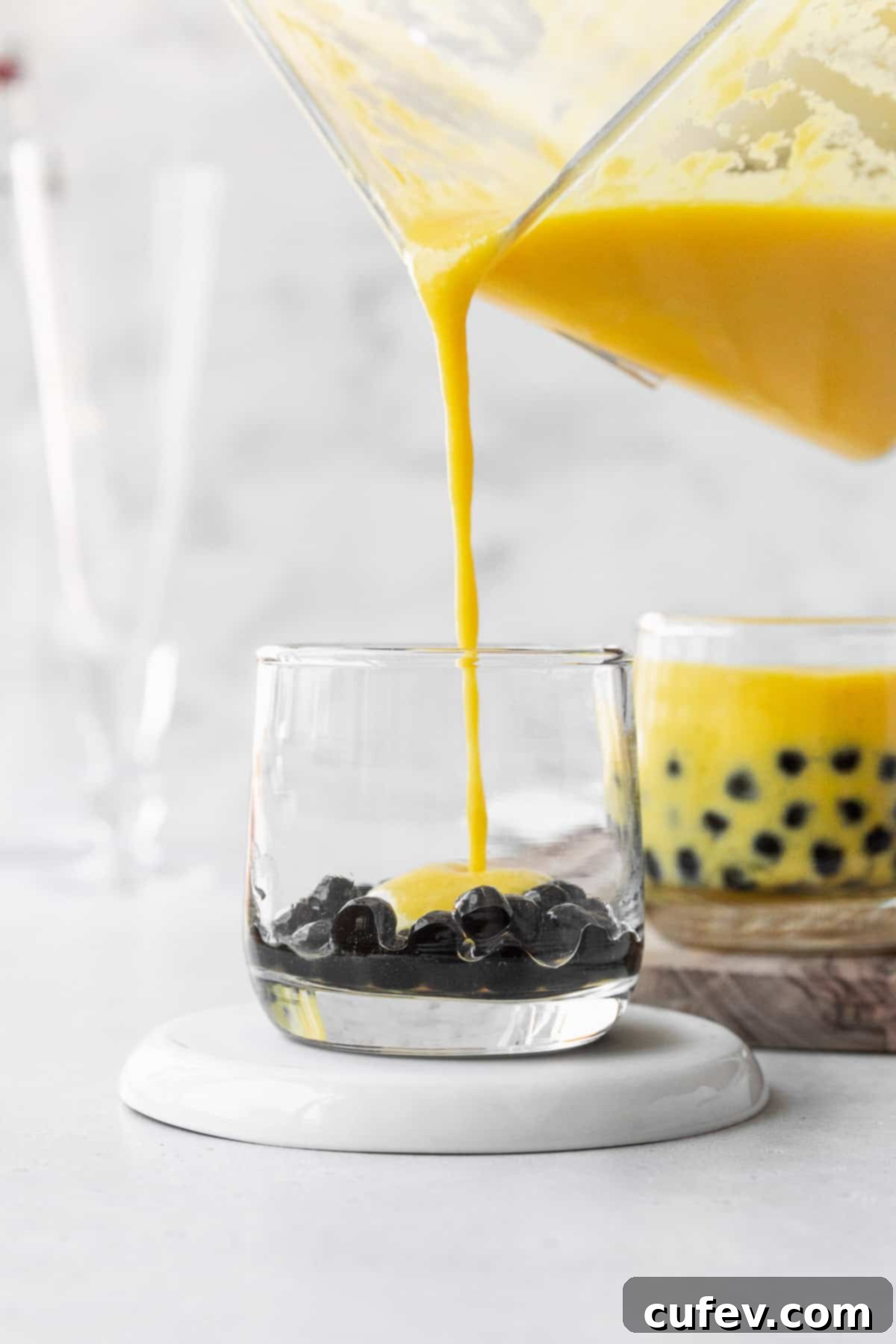

Recipe Success Tips
Achieving the perfect homemade mango boba tea is easy with a few insider tips. Follow these suggestions to ensure your drink is consistently delicious and perfectly textured:
- Using Frozen Mango for Convenience. If fresh mangoes aren’t in season or readily available, frozen mango chunks are an excellent alternative. Be aware that frozen fruit can make the mango puree thicker than if using fresh mango. If you find your puree is too thick to easily sip through a straw, simply blend in additional coconut milk, one tablespoon at a time, until it reaches your desired smooth and drinkable consistency.
- Mastering Green Tea Brewing. To unlock the best flavor from your green jasmine tea without any bitterness, precise brewing is key. Heat your water to just below boiling, ideally between 175°F and 180°F (80-82°C). Steep your tea bag or loose leaf tea for only 2-3 minutes. Any longer, and green tea can become astringent. After 3 minutes, promptly remove the tea bag or strain the loose leaves, and allow the tea to cool slightly before using it in the recipe as directed.
- The Importance of Soaking Boba in Brown Sugar Simple Syrup. Cooked boba pearls on their own have a very mild flavor and minimal sweetness. Soaking them in the warm brown sugar simple syrup is a critical step that infuses them with rich sweetness and a hint of caramel, enhancing their flavor dramatically. Aim to let them soak for at least 5-10 minutes, or even longer if you prefer them sweeter and stickier. This also helps keep them from drying out or sticking together.
- Essential Wide Straws for the Authentic Boba Experience. A key part of the fun of boba tea, for both children and adults, is being able to easily suck up the large, chewy tapioca pearls along with the drink. Regular straws are too narrow. Invest in wide boba straws (often reusable) which can be found at Asian grocery stores, online retailers like Amazon, or even stores like Target. They are essential for enjoying your homemade bubble tea properly.
- Avoid Overcooking Boba. Overcooked boba can become mushy and lose its signature chewiness. Always follow the cooking times precisely as instructed. If the package directions differ slightly, stick to the recipe’s recommended times for the best results, as various brands can have slightly different cooking requirements.
- Chill Your Ingredients. For the most refreshing drink, ensure your brewed tea and coconut milk are well-chilled before blending. This helps create an instantly cold beverage without excessive ice, which can dilute the flavor.

Recipe Variations
This mango boba tea recipe is a fantastic starting point, but don’t hesitate to get creative and customize it to your taste with these delightful variations:
- Make It Extra Cool and Frosty. For a thicker, more smoothie-like and intensely chilling experience, blend a handful of ice cubes directly with the mango, coconut milk, and tea. This creates a wonderfully frosty boba mango tea that’s perfect for hot days. Alternatively, you can simply stir a few ice cubes into the mango puree before pouring it over the boba pearls for a less thick but equally refreshing option.
- Embrace a Tropical Twist. Infuse your milk tea with even more tropical flair! Blend half pineapple chunks and half mango with the coconut milk and tea for a vibrant, tangy, and sweet combination. Other delicious additions could include a small amount of passion fruit pulp or a few lychee fruits for an exotic explosion of flavor.
- Experiment with Mango Popping Boba. For an exciting textural contrast and an extra burst of mango flavor, consider using popping boba instead of traditional tapioca pearls. Popping boba are juice-filled spheres that burst in your mouth, offering a different kind of fun experience. The best part? This type of boba requires no boiling, making preparation even quicker and easier! You can purchase popping boba online or at specialty stores.
- Try Different Tea Bases. While jasmine green tea offers a delicate floral note, feel free to experiment with other tea varieties. Use black tea for a bolder, more traditional milk tea flavor, or try oolong tea for a slightly nutty and complex profile. For a caffeine-free option, hibiscus tea can add a beautiful color and tartness that pairs well with mango.
- Add a Creamy Topping. For an extra decadent treat, consider topping your mango boba tea with a dollop of homemade whipped coconut cream or a layer of cheese foam (a popular boba shop topping made with cream cheese and whipping cream for a savory-sweet contrast).
Storage Directions
- Storage: For the ultimate taste and texture experience, this mango boba tea is truly best served immediately after preparation. Cooked tapioca pearls have a tendency to become tough and lose their characteristic chewiness when stored in the refrigerator for extended periods. If you anticipate having leftovers or wish to prepare components in advance, it is highly recommended to store the mango milk tea puree and the sweetened boba pearls separately. The mango milk tea mixture can be stored in an airtight container in the refrigerator for up to 2-3 days. The cooked and syrup-soaked boba pearls, however, should ideally be made fresh for each serving. If you must store them, they can last for a few hours at room temperature in their syrup, but will begin to harden in the fridge. To make a single serving of this drink fresh, simply divide all the ingredients in half and follow the recipe as directed.
Dietary Adaptations
This mango boba tea recipe is already wonderfully accommodating, being naturally gluten-free, vegan, and dairy-free, making it suitable for a wide range of dietary needs. However, a few simple adjustments can further tailor it to specific preferences:
To make it processed sugar-free, you can easily substitute the brown sugar with an equal amount of coconut sugar. Coconut sugar offers a similar caramel-like flavor profile to brown sugar and dissolves well to create the simple syrup, ensuring your boba pearls are still deliciously sweet without refined sugars. Follow the recipe steps as directed, simply swapping the sweetener.
To make nut-free mango milk tea, if you have a coconut allergy or prefer to avoid nuts, substitute the coconut milk with another plant-based milk. Oat milk is an excellent choice as it provides a naturally creamy texture and a neutral flavor that won’t overpower the mango. Soy milk is another viable option, offering a rich consistency. Simply use your preferred nut-free milk in the same quantity as the coconut milk and follow the recipe as directed to achieve a delicious and safe beverage.
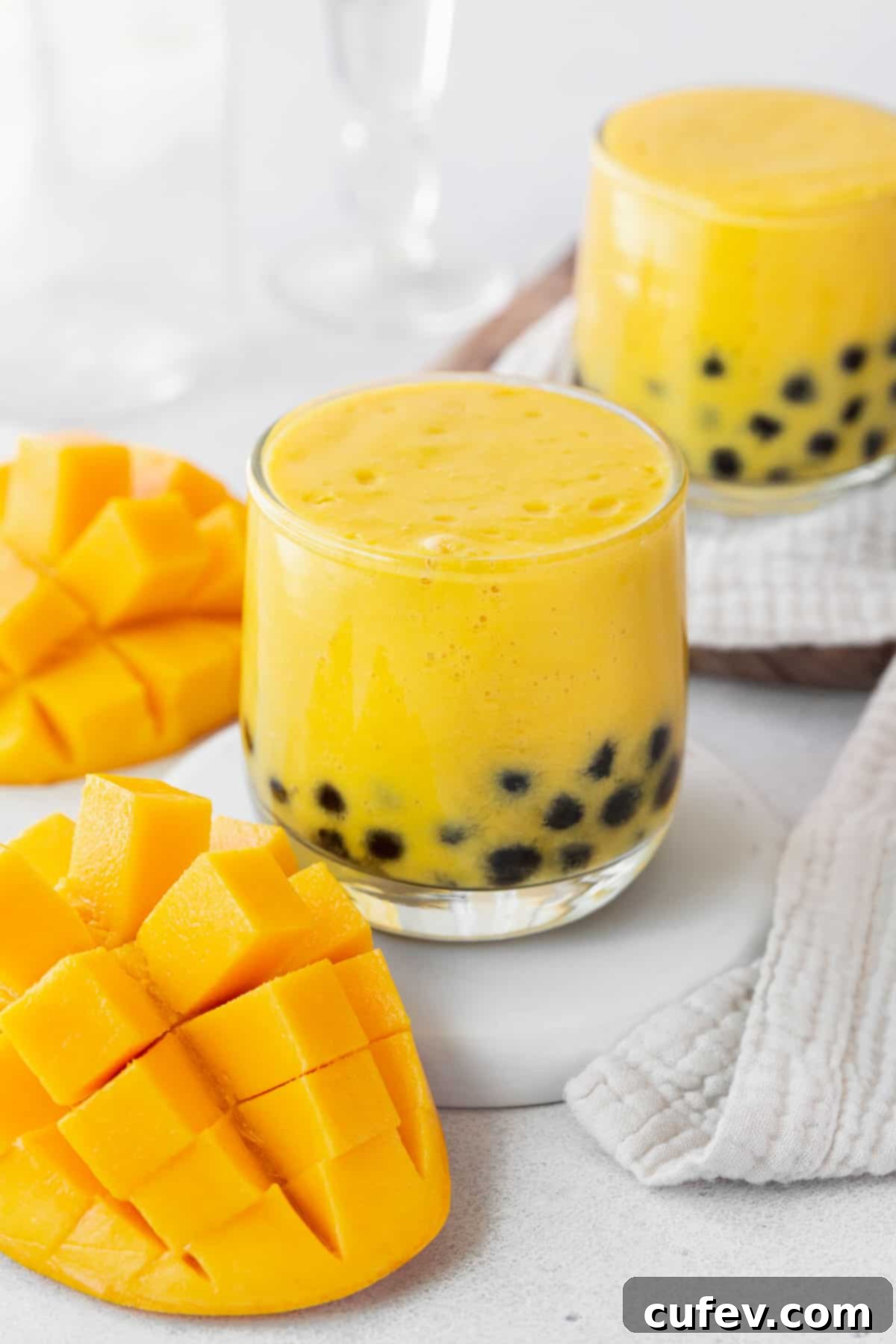
FAQs
Classic boba pearls are primarily made from tapioca starch, which is derived from the cassava root. This starch is mixed with water and often a small amount of brown sugar or caramel coloring to give them their characteristic black hue and subtle sweetness. They are then rolled into small spheres, giving them their unique chewy and gelatinous texture once cooked.
The caffeine content in this mango boba tea largely depends on the type and strength of the green jasmine tea used. Jasmine green tea is naturally lower in caffeine compared to black tea. On average, one cup (8 fl oz) of brewed green tea contains approximately 20 to 60 mg of caffeine. Since this recipe makes two servings of milk tea from one brewed batch, each glass of this mango boba tea would contain roughly 10-30 mg of caffeine. This makes it a relatively low-caffeine beverage compared to coffee or even some black teas.
Yes, classic boba (tapioca) pearls are indeed vegan! Despite their chewy and somewhat gelatinous consistency, they are not made with animal-derived gelatin. Instead, their texture comes from tapioca starch, which is entirely plant-based. This makes them a fantastic, plant-friendly addition to any vegan diet, ensuring that everyone can enjoy the fun and deliciousness of bubble tea.
Boba tea originated in Taiwan in the 1980s, primarily credited to tea shops experimenting with new drink ideas. It quickly gained popularity across Asia and eventually spread globally, becoming a beloved beverage worldwide due to its unique combination of tea, milk, and chewy tapioca pearls.
For the best flavor and sweetness, choose ripe mangoes. A ripe mango will yield slightly to gentle pressure and often have a fragrant, sweet aroma near the stem. Avoid overly soft or bruised mangoes. If using under-ripe mangoes, your tea may lack the desired sweetness and vibrant flavor.
Tools Needed to Make This Recipe
- Cutting Board
- Knife
- Measuring Cups
- Saucepan
- Blender
- Fine-mesh sieve (for draining boba)
- Wide boba straws (for the best drinking experience)
More Fruit Recipes
- Mango Sorbet (2 Ingredients!)
- Lemon Curd Cookies
- Gluten-Free Rhubarb Crisp
- Blueberry Muffins
Thanks so much for stopping by! I truly hope you loved crafting and sipping this delightful Homemade Mango Boba Tea recipe as much as I do. It’s such a refreshing and fun treat to make at home. For even more mouth-watering dairy-free, gluten-free, and/or vegan dessert inspiration, make sure to follow me on Pinterest, Facebook, and Instagram. You can also get all of my newest content delivered straight to your inbox by signing up for my email newsletter — I promise not to spam you!

Mango Boba Tea
Print
Pin
Rate
Ingredients
Tapioca
- ½ cup boba tapioca pearls
- 4 cups water
Syrup
- 2 tablespoons packed brown sugar
- 2 tablespoons hot water
Mango Milk Tea
- 1½ cups mango chunks fresh or frozen (see notes)
- ⅓ cup Nature’s Charm coconut milk
- ⅔ cup jasmine green tea fresh brewed or bottled
Instructions
Tapioca
-
Boil the water in a medium pot. Add the tapioca pearls. Once the tapioca are floating, cover the pot and turn the heat down to medium-low heat and cook for 3 minutes.
-
Keeping the pot covered, turn the heat off and let the tapioca continue to cook for another 2 minutes.
-
Drain the tapioca and rinse with cold water.
Syrup
-
Add the brown sugar and hot water to a bowl and mix until the sugar is completely dissolved.
-
Add the cooked tapioca pearls to the syrup and stir. Move the mixture to the refrigerator until ready to use.
Mango Milk Tea
-
In a blender, add all the ingredients and blend until smooth.
-
Divide the tapioca into 2 glasses and pour the mango milk tea over it. Add ice cubes if desired.
Notes
- Mango: This boba tea can be made with fresh or frozen mango. Frozen can make the mango puree thicker. If using it, blend in additional coconut milk by the tablespoon, or until the mango puree is smooth and thin enough to sip.
- Storage: This drink is best served fresh, as cooked boba pearls get tough when stored. To make a single serving of this drink, just divide the ingredients in half and make the recipe as directed.
